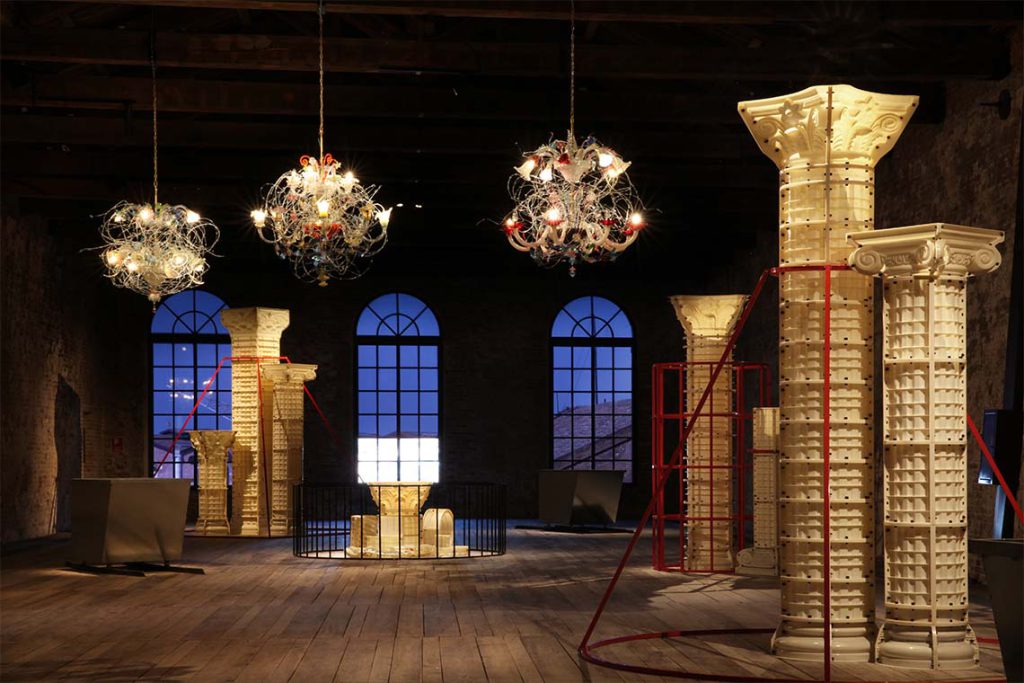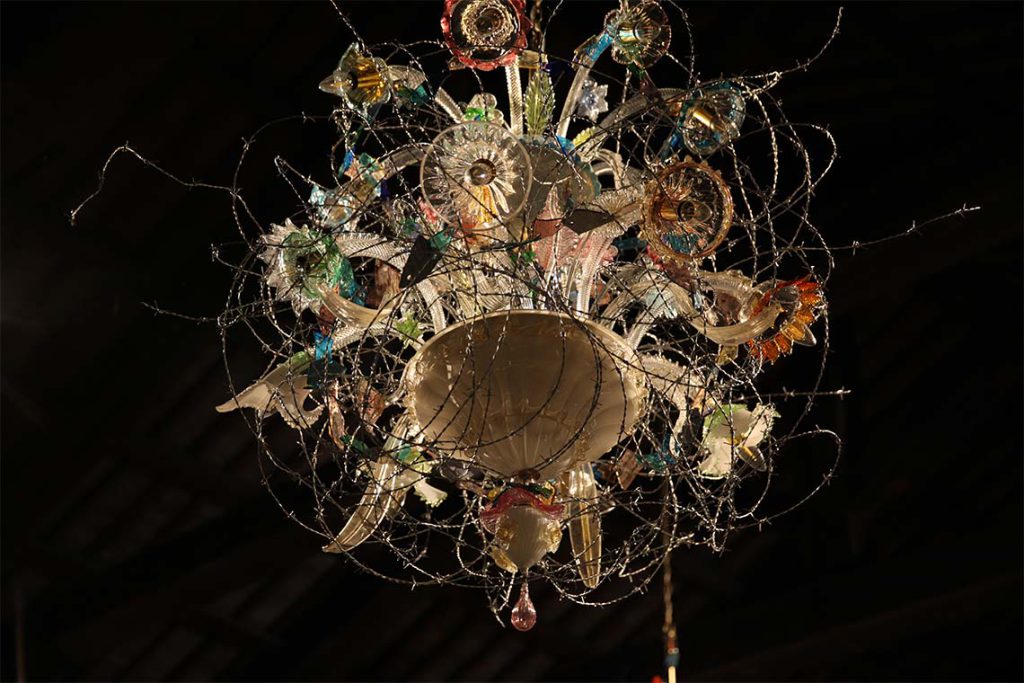A Grande Dame of Turkish contemporary art, the artist represents Türkiye in this year’s Venice Biennale with an installation on beauty and danger.
Canvas: Could you tell us about how you decided to work with glass shards in your presentation?
Gülsün Karamustafa: I was in Venice a few months ago to visit the pavilion to prepare for the exhibition. I have always been an admirer of Murano glass since childhood, so we went to tour the island’s foundries for inspiration. The glass was so colourful and attractive. I saw a pile of discarded shards in a container and felt a tug at my hand. I immediately felt pain and pulled out my hand, only to see that blood was dripping from my finger. The broken glass was so shiny and inviting, but it also had an alarming feeling. I decided there and then that shards had to be a part of the exhibition.
The installation of large containers with broken glass inside is reminiscent of your Mystic Transport (1992) installation, which you initially exhibited at the third Istanbul Biennial and recently re-staged on the rooftop of Arter for the museum’s unveiling in 2019. Both works use beauty to attract the audience and they also suggest mobility.
I wanted the rails in this installation to point out the pavilion windows from where you can see the water and the ships. The venue’s past as an artillery, to which arms were transported and stored, is an element I wanted to point out. Outside, you can also see the left-over rails that were once used for transportation. By combining this history with glass that is so beautiful, I wanted to mix aspects of danger and harm with the idea of beauty.

There are also three chandeliers, similarly made out of shards and which loosely allude to the three monotheist religions. They hover above the visitors with a hefty glamour, but again their resource resonates with danger and the experience you had in Murano with your finger bleeding.
The chandeliers point to the ideas of those religions, but visually they don’t make any direct reference to them through their shapes or colours. They are also wrapped with barbed wire. In fact, my initial thought was to create cloud-like barbed wire forms which also resembled chandeliers, but the idea of glasses sounded so impressive. I also wanted the reference to light to be stronger. I like how they now look creepy in a way – they are shiny, but full of sharpness and risk.
The pavilion is a long rectangular form. What was your initial reaction to the space and how has that first impression evolved over time?
I immediately stood in the middle of this 45-metre-long rectangular gallery and imagined myself in the middle of Sultanahmet Square in Istanbul, which was formerly a Byzantine hippodrome. I felt a link between two water-dominated cities, which also fought each other quite often throughout history. During my research, I saw that Byzantium and Venice were always in a quarrel and that when the Ottomans took over Constantinople in 1453, they maintained a commercial relationship with Venice even though they were not necessarily getting along.
The other end of the venue has a large screen with the show’s ritual video running on both sides. Could you talk about your resource for the found images and your method of collaging the content?
This is a 13-minute silent film which came out of a desire to have a final word that combines everything in the installation. I especially wanted the ideas of hollowness and being broken to come together. The collaged footages are from an online portal called Critical Past, which I visit quite often. They have a large library of recordings related to global crises and they house videos of recordings from protests, demonstrations and documentations of war. Most interestingly, they have a large archive of propaganda films which I remember used to be shown in movie theaters before the main film started. I licensed as much footage as I could for this work and eventually edited down from over 30 minutes of content.
The video is silent and has a haunting quality, enhanced by the ambiguity of the source material and lack of clarity over what is really happening in the recordings.
I wanted to eliminate the presence of the cameraman with an observing role. They are only ever observant of the suffering of others, but I wanted to focus on the subjects’ realities as expressed through their own faces. So I deleted all the voice-overs and reporting to leave the viewer with the human condition of the people looking back at us.

You have worked with a variety of media throughout your career and even co-directed the award-winning feature film Benim Sinemalarım (My Cinemas) with Füruzan in 1990. How do you travel between different materials and settle on a form of expression, whether it is painting, film, sculpture or textile?
I don’t commit to any medium necessarily or make a special choice. I let the medium find me instead. I enjoy not being stuck with anything and will just hop on a texture that best expresses me. Sometimes they influence one another, though. I have been painting for so long, and in a way textiles came in as a result of that. Later I found myself doing collages as a result of my work with fabrics.
Painting seems to have a special place in your heart, perhaps through one of your most widely known series, titled The Prison Paintings, which came out of your imprisonment in the 1970s, when you joined the protests against the military coup.
I never want to leave painting. Besides the prison paintings, I have always painted icons, especially female figures, and when you paint such mythical forms, you have the freedom to be playful.
How did you imagine the movements of visitors to the pavilion space and have you made any conscious decisions to guide them around the work?
I think people will move around the space as I have. My first reaction was to feel the space, which is bookended by large windows by one side and a wall on the darker side where I exhibit the film. I am aware that people have limited time and attention in each pavilion, so I wanted to invite some movement on their part.
This interview first appeared in Canvas 113: Common Threads
The 60th International Art Exhibition – La Biennale di Venezia runs until 24 November 2024



